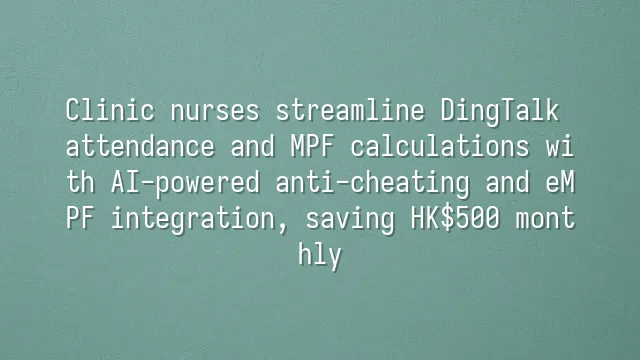
Why Nurses' Clock-In Always Has a Slightly Sketchy Vibe
The gap between clinic nurses’ clock-in records and MPF calculations often starts with the most basic timekeeping habits. A broken time clock in the morning, forgetting to clock out after a tiring night shift, or a "helpful" colleague clocking in for you—these seemingly minor oversights are quietly triggering compliance landmines for Mandatory Provident Fund (MPF) contributions. According to Article 41 of the Labour Ordinance, nurses should not work more than 36 hours of overtime per month, yet a 2023 study revealed that 35% of medical disputes originate from inaccurate working hour records. Even more serious: these irregular attendance patterns directly affect MPF contribution bases. If night shift allowances aren’t properly recorded, they won't count toward eligible income, causing monthly retirement savings to evaporate by HK$300 to HK$500. Data from iHR systems shows high rates of irregular attendance in high-turnover industries—not due to employee laziness, but because of a lack of real-time verification mechanisms. By the time the eMPF platform fully launches in 2025 and offset arrangements are abolished, discovering broken contribution records may be too late—even extra payments might not fix it. Clearly, clinic nurses’ clock-in practices and MPF calculations are intrinsically linked—accurate working hours mean secure retirement protection.
DingTalk Sees More Than the Boss’s Eyes
When traditional time clocks devolve into games of trust, clinic nurses’ DingTalk attendance tracking and MPF calculation need technological intervention to restore credibility. The DingTalk smart attendance system combines facial recognition and GPS positioning to completely eliminate proxy punching. After implementation at a Shenzhen-based chain clinic, abnormal attendance dropped by 60%, audit time shrank from three hours to just eight minutes, and efficiency improved nearly 27-fold. More importantly, the system automatically flags shift patterns and overtime based on actual schedules, preventing human errors and missed reports. A case study from a Class-III hospital in Zhejiang showed that after adopting DingTalk's scheduling module, shift handover errors decreased by 28% and scheduling conflicts dropped by 78%. Shanghai Renji Hospital’s emergency department even integrated it into their ad-hoc shift-swapping process, ensuring working hour data syncs instantly to payroll modules, even during sudden changes. This mechanism isn’t just surveillance—it’s the foundation for transparent systems. So, whom do you trust: people or systems? The answer is already flashing in AI-powered alert notifications.
MPF Contributions Should Include Night Shift Allowances Too
Many clinics mistakenly believe MPF only covers base salary, unaware that the core of clinic nurses’ DingTalk attendance and MPF calculation lies in comprehensive coverage of “eligible income.” According to MPFA regulations, for nurses earning between HK$7,100 and HK$30,000 monthly, shift allowances, overtime compensation, and performance bonuses must all be included in the contribution base—though items like uniform allowances are exempt. The problem? Night shift allowances typically account for 15–20% of monthly pay, yet are frequently excluded from MPF calculations. EC King, a labour insurance expert, warns that overlooking this can shrink contribution bases by 12–18%, potentially costing senior nurses over HK$500 in lost retirement savings each month. If the attendance system fails to automatically identify night shifts or lacks integration with payroll modules, absurd situations arise where nurses “work night shifts but MPF treats it as daytime off.” Over time, compounding effects could delay retirement by up to three years. Therefore, an accurate clinic nurses’ DingTalk attendance and MPF calculation process must capture every eligible income component from the very first clock-in.
Chaotic Scheduling Leads to Unnoticed MPF Gaps
Small clinics often suffer from erratic “jump-around” scheduling, changing rosters over eight times a month, making it impossible for clinic nurses’ DingTalk attendance and MPF calculation to keep pace. Labour Department data from Q2 2025 shows that staff with frequent schedule changes face MPF contribution interruptions 2.3 times higher than those on fixed shifts—mainly because manual updates lag behind by an average of 7.2 days. Even the most diligent accountant struggles with data gaps caused by high staff turnover. The solution lies in automation: once a nurse clocks in via DingTalk using facial recognition or GPS, the system automatically generates eligible income items and pushes them to the MPF calculation module. Whether working nights today, resting tomorrow, or facing an emergency shift change the day after, all hours and allowances update instantly—no manual input needed. This real-time synchronization aligns perfectly with the eMPF platform’s auto-tracking function, ensuring that no matter how chaotic the schedule, contributions remain stable. Otherwise, by the time warnings come from BCT or AIA, the golden window for correction may have already closed.
Three Must-Do Steps Before eMPF Launches
With Union Trust (BCT) and AIA set to join the eMPF Easy platform in August and September 2025 respectively, clinics have less than three months left to make the switch. Currently, only 30% of healthcare institutions have completed system integration testing; laggards will face delayed contributions and compliance risks. To truly achieve synchronized clinic nurses’ DingTalk attendance and MPF calculation, three actions are essential: First, verify whether the DingTalk system can automatically extract eligible income such as shift allowances and overtime pay. Second, confirm that data can be pushed instantly to the eMPF platform, eliminating the current 7.2-day average delay. Third, check compliance with Regulation 418’s requirement to make contributions within 60 days, especially regarding recalculated severance payments. Additionally, eMPF fee regulation clauses take effect in November, involving adjustments to contribution structures. Rather than improvising at the last minute, start now to connect the entire workflow—from “clock-in → attendance → payroll → MPF”—so with just one tap, retirement security becomes rock-solid.
We dedicated to serving clients with professional DingTalk solutions. If you'd like to learn more about DingTalk platform applications, feel free to contact our online customer service or email at

 English
English
 اللغة العربية
اللغة العربية  Bahasa Indonesia
Bahasa Indonesia  Bahasa Melayu
Bahasa Melayu  ภาษาไทย
ภาษาไทย  Tiếng Việt
Tiếng Việt  简体中文
简体中文 